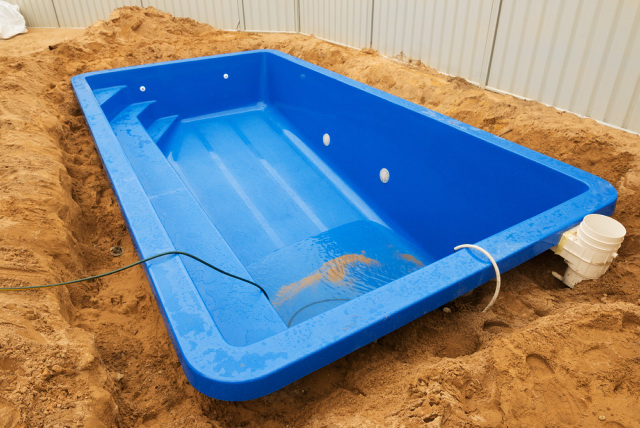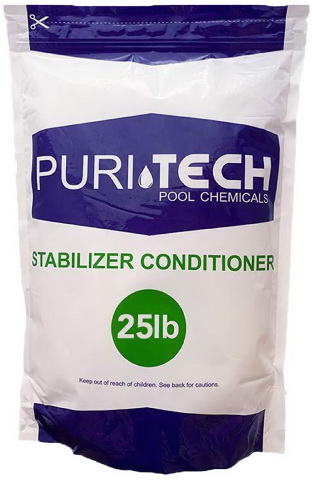If you’re new to owning a fiberglass pool or you’re considering one, then maybe you’re wondering which type of chlorine to use? Can some chlorines cause damage to fiberglass pools? Which is the best and safest chlorine for a fiberglass pool and why?
You can use either chlorine tablets, dichlor, or liquid chlorine in a fiberglass pool. Liquid chlorine disperses whilst tablets, such as trichlor dissolve steadily and contain stabilizer (cyanuric acid), which makes them last longest. Both are safe if used correctly.
There’s a bit more to it than that though. Let’s dig in to find out more.

Article Contents
What Chlorines are Available for Fiberglass Pools?
As you already know, chlorine isn’t just chlorine. It is a blanket term used to describe several types of chlorines:
- Calcium hypochlorite (cal-hypo)
- Sodium hypochlorite (liquid chlorine or household bleach)
- Trichlor
- Dichlor
- Lithium hypochlorite
All chlorine types can be used in fiberglass pools but you must be careful to use them properly or they may damage the pool.
Can Chlorine Damage a Fiberglass Pool?
Chlorine is a strong chemical and used incorrectly it can bleach, blister or damage the surface of a fiberglass pool.
The issue is when undiluted chlorine comes into direct contact with the fiberglass surface. The surface of a fiberglass pool usually has what’s called a “gel coat”. The gel coat is a resin that’s applied to the fiberglass shell. It’s smooth and has a color.
If the gel coat comes into direct contact with strong chemicals, such as chlorine, for an extended period of time, the damage will occur. Keep in mind that it’s the strength of the chlorine and time that will cause the issue. If the contact is for a short period, then it won’t cause problems.
How Can I Avoid Chlorine Damaging My Fiberglass Pool?
It’s all in the way you add chlorine to your pool. If you add chlorine to your fiberglass pool correctly, you won’t have any issues.
Chucking chlorine tablets in the water and letting them sit on the pool floor will cause issues though. Same with any of the powdered or granulated chlorine types.
For chlorine granules, always pre dissolve them by adding them to a 5-gallon (19 L) bucket of pool water. Then with the pool pump running, distribute it evenly around the deep end. This way they will not sit, undissolved, on the pool floor.
And if you’re using chlorine tablets, like trichlor, cal-hypo, or dichlor, use a chlorine floater or chlorinator (chlorine feeder).
If you do use a floater, be careful it doesn’t get stuck in a corner or near the steps. This can cause a concentrated area of chlorine which can damage the fiberglass surface of your pool.
What Chlorine to Use for a Fiberglass Pool
All chlorine types have their uses. But some are better than others.
For everyday chlorination of fiberglass pools, sodium hypochlorite (liquid chlorine or household bleach) and dichlor or trichlor are good choices.
Here’s a summary of different chlorines for fiberglass pools:
| Chlorine Type | Use | Stabilized? | Pros | Cons |
| Calcium hypochlorite (cal-hypo) | Best as a pool shock, not daily chlorination | No | Powerful, cheap | Increases calcium (OK if calcium in water low) |
| Sodium hypochlorite (liquid chlorine or household bleach) | Great for daily chlorination | No | No by-products left, mixes quickly, easy to use. | Heavy to carry, not as convenient. |
| Trichlor | Great for slow release chlorination | Yes | Slow to dissolve, powerful, usually cheapest | Must be used properly to avoid damage to the pool |
| Dichlor | Good for ongoing chlorination (be careful as it will increase stabilizer levels) | Yes | Fast dissolving, doesn’t leave by-products | Contains high levels of stabilizer |
| Lithium hypochlorite | Not Recommended | No | Expensive and not widely available |
Let’s take a look at each chlorine type in detail and when you should use them in your pool.
Can I Use Cal-Hypo Chlorine in a Fiberglass Pool?
Calcium hypochlorite or cal-hypo is affordable, easy to acquire and use, and is very efficient.
Calcium hypochlorite is suitable to use in a fiberglass pool. It comes in tablets and granules. The granules must be pre-dissolved first before adding to the water. It is one of the strongest chlorines on the market. It is also unstabilized chlorine.
Since it’s not stabilized, it’s perfect for a pool shock. It is one of the most popular pool shocks today and has been for some time.
If you have high calcium levels in your pool’s water, don’t use this chlorine as it will increase the calcium levels further.
Pros
- Cheap
- Extensively used, which makes it easy to acquire
- Powerful and will increase chlorine levels quickly
- Dissolves quickly
Cons
- Increases water calcium levels
Can I Use Sodium Hypochlorite (Liquid Chlorine) or Bleach in a Fiberglass Pool?
Sodium hypochlorite is commonly known as bleach or liquid chlorine. It’s also unstabilized chlorine, which makes it a good choice if you don’t want to increase your stabilizer (CYA or cyanuric acid) levels.
Liquid chlorine or bleach is highly recommended for fiberglass pools. It mixes quickly with the pool’s water and doesn’t leave behind any by-products. Liquid chlorine is usually the choice of pool technicians.
Pros
- Easy to use
- Leaves no by-products
- Mixes with pool quickly
- Can add directly to pool (no dissolving)
Cons
- Heavy to carry (and you need a lot of it)
- Short shelf life (don’t buy it in bulk)
Is Bleach Different from Pool Store Liquid Chlorine?
The only difference between the stuff you buy in the pool store and household bleach (like Clorox), is the strength. Household bleach is about 6-8% strength and liquid pool chlorine is around 12%.
The other difference is that sometimes household bleaches add scents and perfumes.
Can I Use Trichlor in a Fiberglass Pool?
Trichlor can be used in a fiberglass pool. To avoid the possibility of damaging your fiberglass pool, make sure trichlor tablets do not come in direct contact with the walls or floor of fiberglass pools. It should be used in a chlorine floater or in an inline chlorine dispenser (chlorinator).
If you do use it in a floater, be careful the floater doesn’t get stuck in one area of the pool. This can cause strong concentrations of chlorine in one spot and damage the gel coat.
Trichlor has a much high concentration of chlorine than other chlorines. It’s around 90%, the strongest on the market. It’s also a stabilized chlorine but contains far less stabilizer than dichlor.
Pros
- Easy to use
- Slow to dissolve and therefore ideal for ongoing daily chlorination
- The cheapest form of chlorine
Cons
- Strong – be sure to use it properly to avoid damage to pool walls and floors
Can I Use Dichlor in a Fiberglass Pool?
Dichlor is common pool chlorine and it contains the stabilizer – cyanuric acid. It’s usually sold in a granule or powder form. The available chlorine is around 55-60%. Trichlor is about 90% and cal-hypo is 60-70%.
Dichlor is suitable to use as chlorine for fiberglass pools. It does not increase calcium levels as cal-hypo does. It does however contain high levels of stabilizer. If your stabilizer (CYA) levels are already high, don’t use this type of chlorine until the levels come back down.
The effectiveness of your chlorine may be compromised if there is too much stabilizer in the pool.
Pros
- Affordable
- Fast dissolving
- Doesn’t leave by-products behind
Cons
- Contains a high level of stabilizer (only a problem if your stabilizer is already high)
Can I Use Lithium Hypochlorite (Lithium-Hypo) in a Fiberglass Pool?
These days, lithium hypochlorite isn’t recommended for a fiberglass pool as it is expensive. It’s also not as easy to get as other common chlorines. Stick to other chlorines.
Should You Use Stabilized or Unstabilized Chlorine for Fiberglass Pools?
Stabilized and unstabilized chlorine both have different uses. The chlorine you use will depend on your pool chemistry at the time and your pool location.
As the name would suggest, unstabilized chlorine is pure chlorine, with no additional stabilizers. It commonly comes as:
- Sodium hypochlorite (bleach or liquid chlorine) and;
- Calcium hypochlorite
Stabilized chlorine contains cyanuric acid. Without the cyanuric acid, the sun’s ultraviolet rays would break down the pure chlorine in a matter of hours, so the water in your pool would require chlorine to be added in large quantities. That is unless there is already sufficient stabilizer in the water (30-50 ppm).
Stabilized chlorines include:
- Trichlor (lower in stabilizer compare to dichlor)
- Dichlor (higher in stabilizer compare to trichlor)
Is Stabilized or Unstabilized Chlorine Better for a Fiberglass Pool?
Both stabilized and unstabilized chlorines can be used in outdoor fiberglass pools. It’s important to maintain a stabilizer in your pool’s water at 30-50 ppm.
When stabilizer (CYA) levels are higher than 50 ppm, use unstabilized chlorine.
When stabilizer levels are 30-50 ppm, use stabilized or unstabilized chlorine. Just keep in mind that if you use stabilized chlorine, this will increase the stabilizer levels in the water. Unlike some other pool chemicals, stabilizer doesn’t evaporate or get used up.
The only way to remove it is to remove water from the pool. This happens through splashing, backwashing and when it rains, the rain dilutes the levels.
See this article on lowering stabilizer levels if your stabilizer is too high.
And when stabilizer levels are below 30 ppm, use stabilized chlorine. You may also need to add a stabilizer (cyanuric acid) to bring up the levels.

For indoor fiberglass pools, unstabilized chlorine is the best chlorine to use. Indoor pools don’t need stabilizers in the water as there is no sun to degrade the chlorine.
Chlorine for Fiberglass Pools FAQs
Which Pool Shock to Use for Fiberglass Pools?
The best choice of shock for a fiberglass pool is liquid chlorine or calcium hypochlorite.
Cal-hypo is easier to use though. You’ll need far less weight because it is much stronger than liquid chlorine. But don’t use it if your calcium levels are high already.
Both of these pool shocks are unstabilized. So be sure you add the products at night when the sun isn’t out to avoid burning off the chlorine too quickly.
Can Chlorine Tablets Damage Fiberglass Pools?
Chlorine tablets like dichlor, trichlor, or cal-hypo can damage the surface of fiberglass pools. It’s important to keep these chlorine products from directly touching the walls and floors. They are all strong products and will cause bleaching, blistering, and damage to the gel coat or resin surface.
Can Chlorine Granules Damage a Fiberglass Pool?
Dichlor and calcium hypochlorite often come in powder or granule form. Both of these types of chlorine will damage the surface of a fiberglass pool if they are allowed to sit on the surface for an extended period of time.
That’s why it’s best to first dissolve these products in a bucket of water before adding them to the pool. If you do notice these sitting on the surface, you can use a pool brush to distribute them.
How Much Chlorine Should You Add to a Fiberglass Pool?
The size of your pool and its current chemical composition directly affect the amount of chlorine you use for sanitation at any particular time. The general guideline should be to maintain a chlorine level between 1 and 5 ppm.
The amount of chlorine you need to add to your pool depends on the type of chlorine and its strength.
Keep in mind, you don’t want to exceed 5 ppm of chlorine. While chlorine is a good sanitizer, too much of it can cause lung and eye irritation, skin irritations such as rashes, throat pain, nose irritation.
Related Reading:
Which Chlorine to Use for Inground Pools?
5 Chlorine Options to Keep Kiddie Pools Clean and Safe






